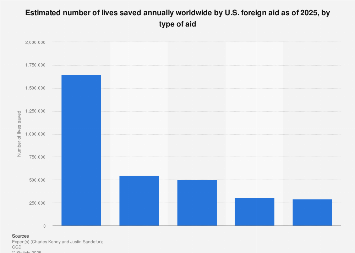I think it is time the U.S. just stop. American taxpayers should read the room. At only 18 cents per day per average tax payer the UK and Europe should have zero problems taking over and expanding their programs, without any of the baggage the U.S. has. Denmark, Luxembourg, Norway and Sweden along with the Gates Foundation are all pretty generous. Classifying money spent on border control and illegals, and asylum cases, as "international development aid" is not on though.
1. A new study in The Lancet estimates the United States Agency for International Development saved 91 million lives from 2001 to 2021.
"We found that the average taxpayer has contributed about 18 cents per day to USAID."
"What we really tried to draw out was, how did the funding from USAID influence a set of outcomes?" says Macinko. "We were most interested in looking at mortality, to really be able to quantify the impact of these investments."
The team analyzed demographic and death data from 133 different countries that received aid between 2001 and 2021.
...those effects were substantial. They found that high levels of USAID funding were associated with a 15% reduction in deaths from any cause, across all ages. For children under five, the percentage more than doubled to 32%.
"Once you translate that 15% reduction into the number of lives, it actually represents 91million deaths averted," says Macinko. "When we saw that number, we were indeed surprised."
2. The Center for Global Development (CGD) made "back-of-the-envelope" estimates for the number of lives saved by U.S. foreign aid worldwide per year and found that U.S. foreign aid prevented almost 1.65 million deaths per year just from HIV/AIDS. Furthermore, the CGD estimated that U.S. foreign aid saved just over half a million lives per year from vaccine-preventable diseases.
The Center for Global Development (CGD) made "back-of-the-envelope" estimates for the number of lives saved by U.S.

www.statista.com
3. Our core estimates are for deaths prevented from HIV/AIDS, vaccine-preventable illnesses covered by Gavi, TB, malaria, and emergency/humanitarian relief. We suggest the number of lives saved per year may range between 2.3 to 5.6 million with our preferred number resting on gross estimates of 3.3 million. We briefly discuss some other lifesaving interventions financed by US assistance in a later section.
Most US assistance isn’t focused on simply and directly saving lives. Even within health, resources are directed to reducing the debilitating effect of diseases that usually don’t kill you. Polio, for example, permanently paralyzes about one in 200 of those infected, and “only” kills about 5-10 percent of those paralyzed. US assistance for polio vaccination through the decades has prevented ten to twenty cases of paralysis for every life saved.
...the US contributing
$4.5 billion to the Global Polio Eradication Initiative over the past 35 years preventing an estimated
2.4 million paralytic cases in Initiative countries.
Or take a case of indirect impact: children of educated mothers are less likely to die young, as are children in more wealthy countries. US assistance for education or infrastructure has a considerable long-term effect on health.
In 2014, about 780 million people lacked access to clean water.
Between
2008-2019, USAID’s assistance resulted in 53.7 million people gaining access to sustainable drinking water.
4. Vaccines are one of humanity’s greatest achievements. An estimated 154 million lives have been saved over the past 50 years thanks to global immunization drives as part of the
Expanded Programme on Immunization (EPI),
led by country governments worldwide, including the U.S., and supported by global institutions.
Vaccination accounts for 40% of the worldwide improvement in infant survival over these 50 years, and
more children now live to see their first birthday and beyond than at any other time in human history.
Since 2000, Gavi has protected an entire generation – over 1 billion children – against infectious diseases, helping to cut by half child mortality in 78 lower-income countries. From 2000-2023, Gavi supported 637 vaccine introductions and vaccination campaigns to protect children around the world against 16 life-threatening infectious diseases. Not only are vaccines delivering protection and high impact, immunization is a ‘best buy’ in health with a return on investment of $54 for every dollar invested.
Safeguarding children and adolescents from deadly, yet preventable diseases, such as polio, measles, diphtheria, pertussis, human papillomavirus and tetanus, among others, is the foundation of the Expanded Programme on Immunization (EPI) – saving an estimated 154 million lives and adding over 10...

www.who.int


